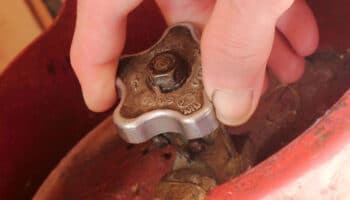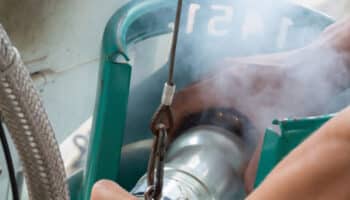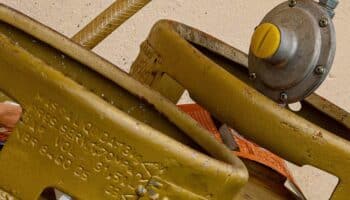We've independently reviewed this article to make sure it's as accurate as we can make it.
To find out more about our article creation and review process, check out our editorial guidelines.
After putting it off forever, you’ve finally decided it’s time to renovate your bathroom. First stop: the shower. You’ve banished the old (and possibly rusty) shower head to the garbage, and the shiny new one is ready to install.
Installation is easy enough. You twist the shower head into your water connection, and… it’s pointing up instead of down.
What gives? Well, your plumbing isn’t topsy-turvy, and your new shower head probably isn’t defective. It’s likely an issue of the connection being too loose or tight.
In this article, we will review the quick and easy process of fixing a shower arm pointing up.
To fix a shower arm pointing up, do the following:
- Determine how tight the connection is.
- Remove the shower arm from the wall.
- Add thread seal tape or plumber’s grease as needed.
- Re-install the shower arm.
- Check your work.
What You’ll Need:
- Thread seal tape
- Plumber’s grease
- Pipe wrench or pliers
- [Optional] A screwdriver to be inserted into the end of the shower arm for leverage – to avoid damaging the shower arm with pliers
- Rag or cloth
Read on to get your shower arm straight!
Why a Shower Arm Might Screw-in Pointing Up
To install a shower arm, you have to rotate the pipe fitting until it’s securely in. However, “securely in” could be upside down, like in your case.
In my experience, more often than not, the shower arm likely hasn’t been rotated enough times. One additional rotation will have the showerhead pointing in the right direction.
As it turns out, not all pipes fit together like perfect puzzle pieces. But luckily, addressing the situation is quite simple, and you can do it yourself.
How to Loosen a Stuck Shower Arm and Point it Down
Loosening a stuck shower arm may sound challenging, but in my opinion, it’s one of the easiest parts of the entire installation process. Here’s what you have to do:
Step 1
Before removing the upside-down shower arm, gently twist it with the wrench. You need to determine how much give you’ll need.
If the shower arm has a little bit of give and you feel the pipe could rotate enough with a little help, then you can help it along.
On the other hand, if it’s an all-or-nothing deal – one way is too loose and leaky, and the other is too tight and pointing up – then you’ll have to go another way.
Step 2
Next, to fix your shower arm pointing up, you’ll need to remove the shower arm. The best way to remove the shower arm depends on how tightly you installed it in the first place.
From what I’ve seen over the years, if you hand-tightened the shower arm, you can likely twist it and remove the pipe fitting without any tools.
If the arm is locked tight, you might need metal assistance. A shower arm usually has male threads on both ends. The short side attaches to the drop-ear elbow on the shower wall and the long end points toward the tub.
If a shower arm must be torqued with a wrench, pros will use a rag to cushion the shower arm and turn the pipe with channel lock pliers, being careful not to scratch the shower arm with the pliers.
Typically, you’ll need to turn the shower arm counterclockwise to remove it. Using your tool of choice, loosen the shower arm until it’s out or until you can loosen the remainder by hand.
Do not use excessive force!
Step 3
Next, to fix your shower arm pointing up or remove a stuck shower head, you’ll need to grease up the pipe threads with some plumber’s grease.
For the more complex issue, grab some PTFE tape. Wrap two to three layers of plumber’s tape on the pipe thread. It’s best to wrap the tape clockwise so that you won’t unthread the pipe when you twist the arm back into the wall.
If you happen to have the shower equipment’s original packaging, check out the material it’s made of. Softer metals like brass, silver, copper, or lead need more tape layers. The softer the metal, the more risk you have of breaking it – so don’t use too much force!
If you don’t know what metal you’re dealing with, that’s okay too. Most shower arms on the market today are made with chrome or sometimes nickel. Chrome and nickel are hard and not as delicate as brass and the like.
Step 4
Try to insert the pipe back into the wall. You’ll be turning the pipe clockwise this time. Also, be careful and make sure the pipe is threading properly into the hole. If not, you could be dealing with cross-threading, which can damage the threads of your pipe.
Once you’ve completely twisted the shower arm, you’ll find out whether your lubricant or grease solved the issue. If so, your shower arm should be secured and facing the right direction! Hooray!
If not, time to head back to step 2. You’ll need to remove the arm again and then apply more Teflon tape or plumber’s grease layers. Afterward, try installing the pipe fitting again. Repeat until the shower arm is pointing down.
Step 5
The last step in removing a stuck shower head or addressing a shower arm pointing up is to check your work! With all your twisting and taping, you’ll want to check that everything works and nothing leaks. Try putting the showerhead on the arm and then turning on the water.
Hopefully, the shower works as expected and you don’t find any leaks! If you see water escaping, some more thread-sealing tape may be in order; unless your shower head came with a rubber gasket to seal it.
Conclusion
An upside-down shower arm is more than just an annoyance.
Short of sticking yourself on the ceiling, Spiderman-style, it would be impossible to take a shower with such a problem.
Hopefully, this how-to guide made the issue easy to fix, and your shower is good to go.
Thanks for reading. If this article piqued your interest and helped you, please consider checking out our other resources below and subscribing to our newsletter.
Happy shower.
-Craig.







